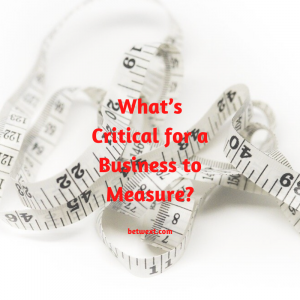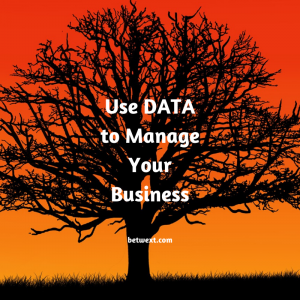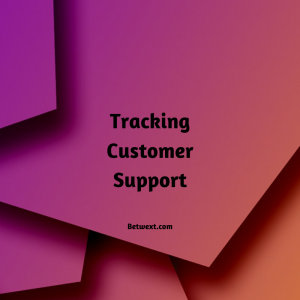Don’t be STUPID – Know Your Numbers…
Editor’s Note: This article is part of a bigger series on supercharging the growth in your business. To start at the beginning click here – Nine Critical Strategies to Grow Your Business in 2020!
My last article went a bit long… we talked a lot about the importance of Profits for a business owner.
But that brought up a lot of questions.
As people went wading through their finances, focusing on growing revenue… or cutting costs… the question came up over and over again…
What Numbers Should I be Following?
It’s said the great business management guru – Peter Drucker – uttered the phrase…
“That which gets Measured gets Managed.”
It’s a great quote, but Drucker never said it.
And there’s a bigger problem… you can measure almost anything… that doesn’t mean you should. Measuring the wrong things can be a bad waste of time. Still worse, if you have the wrong data, you’ll make bad business decisions.
In software, many companies produce a “Dashboard” to give a user vital statistics… we’re guilty of having that feature here at Betwext.com. (Remember, we make great texting software!)
But the problem is, many of these dashboards measure the wrong data.
Or worse, they measure too much data.
Facebook should be put on trial for the amount of useless data they provide. If you’ve got a Facebook ad account, just look at your campaign overview page… you’ll see more than a dozen datasets you can look at… and each data set has dozens of data points.
It’s enough to drive a marketer crazy.
But I understand why they do it.
Facebook has (as of my last round of research) some 7 million advertisers on the platform. And each one of those businesses are different – so they need to look at different data.
But it creates a problem…
What’s Critical for a Business to Measure?
Sorry, I can’t just give you a list of things to track.
This is where you need to step up and use your brain and figure out what’s most important for you and your business.
I will however give you some help.
I want you to think of your financial numbers like the branch of a tree.
The trunk of the tree holds the big numbers – financial numbers. Revenue, Cost, Profit, Assets, Liabilities, CASH. You know big ones!
Then you have numerous branches… one for marketing and sales… one for production and manufacturing… one for customer service… one for shipping… and so on.
Then each branch will have little twigs where the data sets become very specific. For example, in marketing it might be page views, or site visits. For production it may be equipment downtime or machine throughput. Shipping might measure time to ship, or on time delivery, or shipping damage, or returns.
You see how each and every business is different… and the data sets you should follow are very different.
Here’s a real world example.
In the Cabinet Company… we measure shop efficiency. We look at things like the number of shop hours spent for a project verses our original project estimates. It’s critical we know those numbers… because it tells us if we are under bidding projects.
But for the financial publishing company, we don’t have a shop! So, those shop numbers mean nothing. With the publishing business, the most important things for us to track include email delivery, open and click rates…
In this example email stats are tracked by the Cabinet company marketing team… but they have nowhere near the focus as at the publishing company.
Here’s What I’m Planning to Track…
The funny thing is, I’m about to launch a new business in the telecom space. It’s a business focused on delivering low cost phone, voicemail, and texting services to small businesses and entrepreneurs.
And I’ve been trying to figure out what we should be tracking.
This is what I’ve come up with so far…
- Cash
- Revenue
- Expenses
- Profit
That gives me a good overview of the entire business. And by the way, I’ll look at cash balances almost daily… along with daily sales numbers. But the others, like expenses and profit… those will get measured monthly.
FYI – every business I work with does financial numbers monthly… and if you don’t… start doing that right now.
Often I discover when businesses are in trouble the owners are ignoring their financial statements.
Here’s a not so funny story. I rescued one business from the brink of bankruptcy… literally with hours to spare. It turns out the owner was 3 years behind on his business taxes… and hadn’t done a financial statement in almost 26 months.
His numbers were not good… and not doing them didn’t help the situation.
Needless to say, that was the worst business partnership I ever got involved in… and I regret it to this day. But that’s another story for another time…
Now that I have my big picture reporting, I’m going to focus on marketing.
Tracking Marketing
Now, don’t go crazy.
Like I said just above, with Facebook, and any other advertising platform, the data you can suck out is shocking.
But I’m going to focus on a handful of things.
First, we’re running two types of ads…
One ad redirects people right to an “order now” page.
The second ad directs people to an educational piece of content. Which then has a call to action to buy at the bottom of the page.
Here’s a critical piece of information… Our order page has two steps. First you create an account, then you drop in your credit card information.
Finally, both pages will have the option to drop an email or phone number to get a demo. (Believe it or not, I’m going to use Betwext.com to text people their requested info!)
So what am I going to track?
- Total ad spend in dollars.
- Number of accounts created
- Number of paid customers who signed up
- Number of demonstrations requested.
That’s it.
You’ll see each of these data sets provides some interesting numbers… and we’ll use these numbers to manage the business.
But ultimately I’m focusing on one number… My CAC.
My CAC is my Customer Acquisition Cost.
CAC is calculated by taking the number of PAID accounts and dividing it by the total ad spend.
So, If I spend $1,000 marketing this product, and we get 25 Paid customers… 1,000 / 25 = $40 per paid customer.
Now I have a number I can track over time. Changes I make to the advertising efforts will either make this number better or worse.
Now before you say anything I know there are loops in the data… for example, we have a follow-up sequence for prospects that create an account but have not yet dropped a credit card. It’s a series of emails, texts, and personal calls.
Of course we’ll track that data too to see what’s working and what’s not… and eventually cut the stuff that does not work. When we dial that in, it will improve the CAC.
We’ll also follow-up with prospects that requested system demos.
Our sales team will track the number of Demo requests we get, and what the conversion rate is to paying customers. That’s it… number of requests and number of sales. This activity will improve CAC too.
If those numbers are good enough, we might change our advertising to go right to a demo request. See how I’m going to use the data to manage the business?
I’ll probably look at that data on a weekly basis… maybe daily if we’re testing new marketing material.
Here’s an important note… your data is going to be unique. So the timeframes you choose will be important. For example, our product pricing should encourage customers to sign up within a few days of seeing our product.
This is not a multi-million dollar product with a long sales cycle.
If it was, I’d change not only WHAT im measuring but how frequently I monitor the numbers… I’d look to change measurements to monthly or quarterly…
Do you see how you can get bogged down in data?
You need to be careful what information you track and focus on.
For example, if I had a staff of 10 sales people, I’d track sales by salesperson, lead source, response time, connection rate, and conversion rate… just to name a few.
Now that we have a customer… we have new things to track…
Tracking Customer Support
Since we’re just starting out, we’re planning on having a customer support team member reach out to every customer and make sure they get onto the system as smoothly as possible.
Why track this?
So we can make changes to the signup process… and discover where people are getting bogged down.
Here it’s less about tracking numbers, more about tracking questions, comments and problems.
Over time, we’ll also get a feel for our customer service demands… how often do people reach out to us… and what types of support we need to staff. We’re going to start lean and add people only as needed!
Now that we have customers, we’re going to monitor them in batches and see what important metrics we can learn.
For example we’re going to start calculating an important metric… your LTV.
What’s an LTV?
It’s a customer lifetime value. In other words, what will the average customer spend with you over their lifetime.
Why is LTV important?
Another great question. You can use LTV to help get an idea of what to spend on getting new customers. But you want to use it carefully… I’ll explain more in a moment.
Remember the CAC above… that’s your cost of acquiring a new customer?
You want to make sure your CAC is BELOW your LTV… WAY BELOW…
You can also use the LTV to separate customers into high value and low value buckets… and also identify the best customers ahead of time! That’s great in theory, but in practice it’s a bit more difficult.
Here’s my plan…
I’m going to take the first 25 customers that signup and that will be my data group. (Some people call it a cohort, but for some reason I don’t like that word… “group” is good enough for me, Mr. PHD.)
Anyway, I’m going to look at these 25 customers and measure a few things.
First I’m going to look at their average monthly revenue. On average what do these customers spend with me every month. I don’t have numbers yet, but let’s just estimate that the average customer is spending $14.99 a month.
Second, I’m going to look at how long they have an account open and active. Again, I don’t have data, but let’s assume they stay using the system for 14 months. That might be really high or really low… but we’ll find out over time.
How to Calculate LTV
Now we do some math. If 25 customers average spending $14.99 a month and they use the system for 14 months… their lifetime value is (LTV=$14.99 x 14) or $209.86… let’s just round up and say $210.
Remember, this is an average… so some customers will spend more – much more… and some will spend less… much less.
Theoretically, you can use these numbers to calculate your advertising spend… and some marketing Guru will say now you can spend up to $210 to get a customer!
Wrong, wrong, wrong… I say dial that back buckaroo.
Yea, a LTV gives you some interesting numbers to work with… but they also present two big problems… First, they don’t take into account cash flow or expenses… and, Second LTVs change over time.
Let’s look at the first part of this problem… pretend you sell stuffed teddy bears over the internet. You determine that your customer has an LTV of $125… great… but if you rush out and ramp put your marketing to $125 a customer you’re going to quickly realize two things.
First you’ll run out of cash and second there won’t be any profit left!
If your customers LTV is $125 and you spend all of it on marketing… how do you pay for the cost of the product… or shipping… or customer support… Where do your profits come from?
On top of that, you’re going to run out of money very quickly.
Remember, the $125 is the lifetime of the customer… they might spend that amount over two or three, or more years! If you spend $125 to get a customer… and their first purchase is only $25… you’re now $100 in the hole, and waiting for those next purchases to get back to even.
That’s a recipe to run out of cash very quickly!
The Other Problem With LTV
The other problem with LTV is it changes over time.
Remember, I said I’m going to use my first 25 customers to do the initial calculation… well, a year later, you might use a group of 200 customers to calculate LTV… and you’ll get very different numbers.
At this point you might have other product offerings. Maybe you added in an upsell to increase customer spending. You might have made the system easier to use to lower customer turnover.
So pretend that a year later you now have an average customer spend of $23.45 a month… and the average customer stays for 18 months. Your LTV has changed…
Now your customer LTV is $422.10.
Be careful when using customer LTV numbers… they are changing all the time, and can vary with changes in pricing, billing cycle, product offerings, changes in features. You’ll be surprised at what impacts your LTV.
Because it changes, I’ll look at LTV a few times a year.
Just remember this… Use LTV with extreme caution when managing your business.
So where are we…
We’re monitoring Cash, and Revenue daily, we’re watching expenses and profit too. We’re also going to make a point of tracking CAC… and we’ll use a rough estimate of LTV to keep us honest.
What do we Track Next?
Honestly, nothing.
Looking at Revenue, expenses, profit, cash, CAC and LTV is enough for us to get started.
Could we track other things… Sure… but why?
If LTV is low, I’ll look at pricing and features… and how much customers use the product. If CAC is high, I know I need to spend more time dialing in the marketing.
Cash will tell me if I should speed up or slow down my marketing… or grow or shrink the business. Finally, revenue, expenses, and profit will give me the 20,000 foot view of the business as a whole.
That’s how I plan to manage this new business…
I hope this explanation helps you too. Like I said, each business is different. If you have a shop or manufacturing facility, you’ll develop a set of metrics to track efficiency there. If you have a shipping department, you’ll want to track different metrics in that group.
Remember – overall, less is more.
Here’s a personal piece of advice, if you look at a number and it moves up or down… you should be answering this simple question – Is it good or bad, and what do I need to change?
If you look at a number in your business and you can’t answer why moving it higher or lower is a good thing… maybe you shouldn’t be tracking that number. The same thing can be said for numbers that you have no idea how to influence.
Let me give you an example… Video View Time.
This is simply a measure of how much of your marketing video people watch.
Many marketing people say this is a critical metric. The reasoning… The longer people view your videos the better it is. A long video view time means your videos are useful and engaging.
Low view times means bad videos that need to be improved.
However, in my opinion, this is a useless metric.
The goal of the video is for people to click through to my website and eventually sign up for my product or a demo.
At the end of the day I don’t care how long people watch my marketing videos… What I care about is if they click through and sign up!
Making people watch more of your video is a vanity metric. I’d rather all my videos have 1 second view times and 100% click through rates (Not possible, but one can dream)!
Now of course, if my signup rates are low, I’ll look to improve the video… but I’m improving it NOT to get people to watch more… I’m improving it because I want more signups!
See what I mean… be careful of metrics that on the surface look important… but at the end of the day really don’t help you run your business.
Your Turn to Take ACTION…
I know it’s shocking, but I’ve run out of things to write about.
It’s your turn.
Take a few moments and look at your business. What metrics do you need to be tracking?
What areas of the business can you improve by making changes… now start tracking and changing things… Just remember… Every change needs to get you closer to the goal of bigger profits!
Don’t forget that.
Alright, I’m sure I missed something… if you’re using some other tracking metrics, please let me know. I’d love to hear from you and learn what you’re tracking in your business… and why.
Just email me at brian@betwext.com
One final note… To learn more about Betwext.com… and how it can help your business, click here.
To go to the next article: Click here












